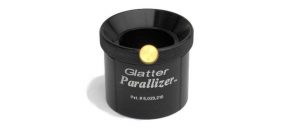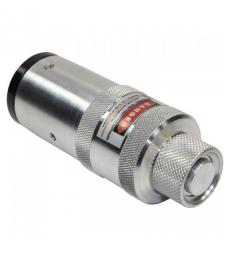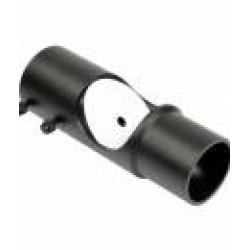Howie Glatter Collimation Tools: The Glatter Parallizer was a brilliant innovation that addressed the need to keep the eyepiece (or other optical accessory) parallel with the optical axis of the telescope.

Howie Glatter understood that centering the optical axis of the eyepiece to that of the telescope – a factor that had already been addressed by numerous “self-centering” designs – is far less critical than that the two axes be parallel. Bottom line: An eyepiece may be off-center by a millimeter or more without significant degradation of the image, but if it is even slightly out of parallel, stars will take on truly ugly shapes. Ditto the performance of laser collimators, even the hyper-accurate collimators Howie had been producing for years. Thus, the Parallizer.
Prior to Howie Glatter’s passing, Starlight Instruments had been making the Parallizer eyepiece-centering adapters designed by Howie, so it was only natural that they also ensure continued production of his the Howie Glatter collimation tools, including the Glatter laser collimators, TuBLUGs, and related accessories.
The Howie Glatter Laser Collimator incorporates a solid-state laser diode that does not fade or change with time and use. It is factory-aligned to 15 arc-seconds providing 0.1-inch accuracy at 20 feet. The Howie Glatter Laser Collimator is also shock resistant to keep its alignment … even when dropped. Each includes includes a 123a lithium battery, a 1.0-mm aperture stop, a case, collimation rings and instructions.

Inside the collimator is a solid-state laser diode, which emits an intense laser beam through a front aperture, exactly along the central axis of the cylindrical collimator body. The beam acts as a “reference line” from which alignments are made. For a laser collimator it is of supreme importance that the beam be aligned with the collimator’s cylindrical axis, for if it is not, the resultant “alignment” of the telescope optics will be off-center and asymmetric, and the telescope will produce aberrated images.
As Howie explained:
“When I started manufacturing laser collimators, I realized that in order to produce consistent and accurate results, they must be highly resistant to mechanical shock, so that internal laser alignment is maintained. I experimented with this aspect of collimator construction

and developed a design which tremendously increased shock resistance. After aligning the laser within 15 arc seconds, I shock test each collimator by whacking it against a block of urethane plastic (urethane prevents marring), striking it at least a dozen times on three axes. I then recheck the laser alignment, and if it has not changed, the collimator passes. I believe this is the most important difference setting my collimator apart from all others I know of. They will withstand a shock equivalent to dropping from eyepiece position, up the ladder on a big Dob, without alteration of laser alignment.
The beam from all red-diode lasers used in collimators is fuzzy-edged and elliptical in cross-section. When collimating, you sometimes must judge the location of the center of the spot by eye. To improve collimating precision, all of my collimators (except 532-nm) are supplied with a removable accessory plastic aperture stop having a 1.0-mm hole, which push-fits into the laser aperture. It produces a tiny, circular beam impact, which allows more accurate alignment. With the holographic collimators, it is not used at the same time as the optional holographic feature, and the diffractor must be removed to install the stop. With the stop inserted, the beam impact at a distance of one meter, or more, looks like a star diffraction pattern, with a central dot surrounded by diffraction rings. The surrounding rings can help in centering the beam very accurately.

I offer the red holographic collimators with a choice of either 650-nanometer or 635-nm wavelength. The two lasers have the same radiometric power output, but because the human eye’s sensitivity to the shorter wavelength is greater, the 635-nm laser appears about two or three times brighter. The higher cost of 635-nm laser diodes increases the collimator price, but it enables optional holographic collimation in brighter ambient light. If you intend to collimate in early twilight, it is a good choice. In darkness, however, the 650-nm laser is quite adequate. Because single-beam collimators concentrate all the laser light in the central beam, the 650-nm laser is quite adequate for them.”
The Howie Glatter Collimation Tools product line lives on thanks in large part to the behind-the-scenes efforts of Jeff Norwood of Camera Concepts & Telescope Solutions, who also aided in continuing production of Howie’s PST Bino Platform by Deven Matlick of Criterion Machining, its original manufacturer.
And to make it easier for you to get the most extensive telescope and amateur astronomy related news, articles and reviews that are only available in the magazine pages of Astronomy Technology Today, we are offering a 1 year subscription for only $6! Or, for an even better deal, we are offering 2 years for only $9. Click here to get these deals which only will be available for a very limited time. You can also check out a free sample issue here.



